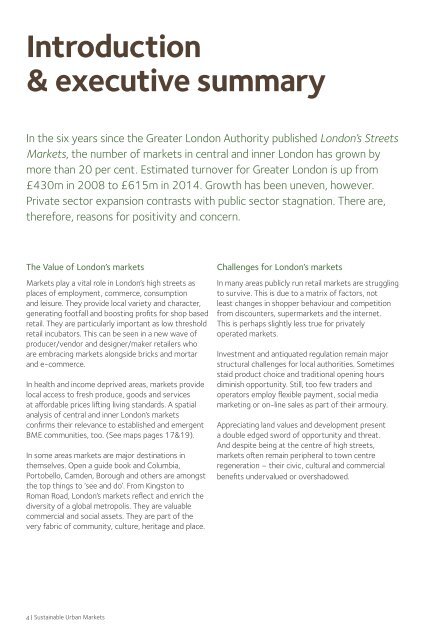Sustainable Urban Markets
Sustainable-Urban-Markets-An-Action-Plan-for-London3
Sustainable-Urban-Markets-An-Action-Plan-for-London3
Create successful ePaper yourself
Turn your PDF publications into a flip-book with our unique Google optimized e-Paper software.
Introduction<br />
& executive summary<br />
In the six years since the Greater London Authority published London’s Streets<br />
<strong>Markets</strong>, the number of markets in central and inner London has grown by<br />
more than 20 per cent. Estimated turnover for Greater London is up from<br />
£430m in 2008 to £615m in 2014. Growth has been uneven, however.<br />
Private sector expansion contrasts with public sector stagnation. There are,<br />
therefore, reasons for positivity and concern.<br />
Image: Old Spitalfields Market, Owain Jones<br />
The Value of London’s markets<br />
Challenges for London’s markets<br />
The National and regional response<br />
The <strong>Sustainable</strong> <strong>Urban</strong> <strong>Markets</strong> project<br />
<strong>Markets</strong> play a vital role in London’s high streets as<br />
places of employment, commerce, consumption<br />
and leisure. They provide local variety and character,<br />
generating footfall and boosting profits for shop based<br />
retail. They are particularly important as low threshold<br />
retail incubators. This can be seen in a new wave of<br />
producer/vendor and designer/maker retailers who<br />
are embracing markets alongside bricks and mortar<br />
and e-commerce.<br />
In health and income deprived areas, markets provide<br />
local access to fresh produce, goods and services<br />
at affordable prices lifting living standards. A spatial<br />
analysis of central and inner London’s markets<br />
confirms their relevance to established and emergent<br />
BME communities, too. (See maps pages 17&19).<br />
In some areas markets are major destinations in<br />
themselves. Open a guide book and Columbia,<br />
Portobello, Camden, Borough and others are amongst<br />
the top things to ‘see and do’. From Kingston to<br />
Roman Road, London’s markets reflect and enrich the<br />
diversity of a global metropolis. They are valuable<br />
commercial and social assets. They are part of the<br />
very fabric of community, culture, heritage and place.<br />
In many areas publicly run retail markets are struggling<br />
to survive. This is due to a matrix of factors, not<br />
least changes in shopper behaviour and competition<br />
from discounters, supermarkets and the internet.<br />
This is perhaps slightly less true for privately<br />
operated markets.<br />
Investment and antiquated regulation remain major<br />
structural challenges for local authorities. Sometimes<br />
staid product choice and traditional opening hours<br />
diminish opportunity. Still, too few traders and<br />
operators employ flexible payment, social media<br />
marketing or on-line sales as part of their armoury.<br />
Appreciating land values and development present<br />
a double edged sword of opportunity and threat.<br />
And despite being at the centre of high streets,<br />
markets often remain peripheral to town centre<br />
regeneration – their civic, cultural and commercial<br />
benefits undervalued or overshadowed.<br />
In recent years a number of committees and reports<br />
have put forward recommendations to improve the<br />
picture. This has failed to elicit a cohesive or sustained<br />
local or strategic response. The landscape remains<br />
atomised and uncoordinated. There are reasons for<br />
optimism, however.<br />
Mary Portas’ independent review of the nation’s<br />
high streets and subsequent pilots emphasised the<br />
considerable value of markets. Government and the<br />
National Association of British Market Authorities<br />
(Nabma) responded by delivering the ‘Love your<br />
Local <strong>Markets</strong>’ fortnight celebrating and re-engaging<br />
communities around markets as commercial and<br />
social assets.<br />
In London, the Mayor has been rethinking high streets.<br />
Since 2011 his Outer London and Regeneration<br />
Funds have invested £120m catalysing local funding<br />
and support to animate places, boost business and<br />
smarten shopfronts. Kingston, Wood Street and Chrisp<br />
Street markets were three that benefited.<br />
To date the Mayor’s investment has put a strong<br />
focus on inner and outer London – areas with growth<br />
potential. The benefits for central London, where<br />
the majority of the capital’s street and covered<br />
markets can be found, have been more modest.<br />
The recently launched Mayor’s High Street Fund now<br />
provides the opportunity for central London<br />
markets to benefit, too.<br />
The challenge to markets and high streets is common<br />
across EU member states. The URBACT programme<br />
funded by the European Commission has partnered<br />
Cross River Partnership (CRP) in London with eight<br />
European cities to share knowledge and develop<br />
city action plans. The project is led by the city of<br />
Barcelona.<br />
CRP has been coordinating and delivering the<br />
<strong>Sustainable</strong> <strong>Urban</strong> <strong>Markets</strong> (SUM) project on behalf<br />
of the City of Westminster, focused on central and<br />
inner London. Although geographically discrete, the<br />
work and proposals set out in this Action Plan have<br />
wider resonance for markets across the capital.<br />
The project team has been led by two private sector<br />
co-chairs – Will Fulford of the <strong>Urban</strong> Market Company<br />
and Camden Lock Market, and Helen Santer, Chief<br />
Executive of Waterloo Quarter Business Improvement<br />
District – operator of Lower Marsh Market.<br />
The project team has blended representatives<br />
from the GLA, Southwark, Lambeth, Camden and<br />
Westminster Councils, as well as the Royal Borough<br />
of Kensington and Chelsea and City of London<br />
Corporation, Better Bankside, Vauxhall ONE, and<br />
Waterloo BIDs, New Covent Garden, Brixton,<br />
Camden Lock and Borough <strong>Markets</strong>.<br />
4 | <strong>Sustainable</strong> <strong>Urban</strong> <strong>Markets</strong> Cross River Partnership | 5


